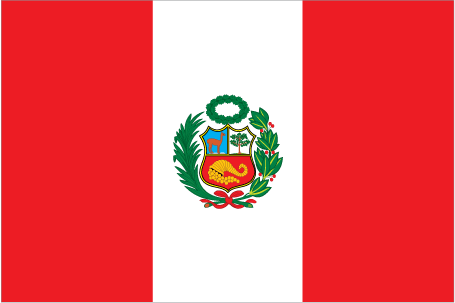To help inspire or plan your trip to Peru, some of its major attractions
for travellers are shown below, including some of the best natural, historical, cultural and adventure sites in the country.
These include all of UNESCO World Heritage Sites for Peru which represent the best
of the world's cultural and natural heritage.
Click on the icons below to focus on specific types of features
(click again to return to all).
|
|
|
|
|
|
|
|
|
|
|
|
 |
|---|---|---|---|---|---|---|---|---|---|---|---|
| Natural | History | Wildlife | Trekking | Cities | Religious Monument | Boat Journey | Rail Journey | Diving | Cultural | Adrenaline | UNESCO WHS |
Northern Peru - Natural attractions
| Huascarán National Park | |
|---|---|
Huascarán National Park is located in the Cordillera Blanca Range of the Peruvian Andes, the highest tropical mountain range in the world. There are 27 peaks over 6,000 metres within the park, with Mount Huascarán at 6,768 metres being the highest. The snow-capped mountains, deep ravines, glacial lakes and variety of vegetation make it a region of spectacular beauty. Important wildlife found in the park include the Andean condor, spectacled bear, puma, mountain cat and white-tailed deer. UNESCO World Heritage Site: Huascarán National Park | |
| Río Abiseo National Park | |
|---|---|
Río Abiseo National Park is located in northern Peru and comprises mountainous landscapes, primary cloud forest and highland grasslands. Created in 1983, the park seeks to protect rare and important species such as the jaguar, spectacled bear, jaguarundi, giant armadillo and yellow-tailed woolly monkey. 36 archaeological sites have been found here with human habitation in the area believed to date as far back as 6000 BC. UNESCO World Heritage Site: Río Abiseo National Park | |
Southern Peru - Natural attractions
| Sacred Valley | |
|---|---|
The Sacred Valley surrounding the city of Cuzco was the heartland of the Inca Empire. In addition to the Inca Trail to Machu Picchu, there are numerous sites and activities available in the area. The vast Inca fortress of Sacsayhuaman lies just outside Cuzco, with an outer wall comprising huge blocks of stone weighing up to 350 tonnes. This was where the Incas made their last stand against the Spanish. Other Inca ruins of note in the Sacred Valley include those at Q’enqo, Puka Pukara and Tambo Machay while the ruins at Pisac sit high above the town offering spectacular views. The colourful Thursday market in Pisac is also well worth a visit. The beautiful landscapes of the Sacred Valley can be explored on foot, horseback and mountain bike while the Grade 3 rapids of the Urubamba River offer some excellent white-water rafting. | |
| Amazon Rainforest (Peru) | |
|---|---|
The Peruvian Amazon is part of the vast area of rainforest which covers 5.5 million km² across nine countries. Flying into the small town of Puerto Maldonado in eastern Peru, a boat trip up the Tambopata River will take you to a jungle lodge from where you can explore the rainforest. Home to more than a third of the world’s plant and animal species, the Amazon is probably the most bio-diverse areas on earth. Walks along jungle trails and boat trips offer the chance to view and explore some of these, including the plants used for food and medicine. Animals that may be spotted include monkeys, boars and a myriad of bird species, as well as giant otters and black caiman on the waters. It's also possible to visit some indigenous Indian communities who live in and off the Amazon rainforest. UNESCO World Heritage Site: Manú National Park | |
| Colca Canyon | |
|---|---|
The Colca Canyon in southern Peru is one of the largest and deepest in the world, twice as deep as Arizona's Grand Canyon with depths averaging about 3,400 metres. There are several villages in and around the canyon, as well as terraced fields that date back to pre-Columbian times. The village of Chivay is a good base from which to explore Colca with excellent trails to appreciate the stunning views. The viewpoint at Cruz del Condor is one of the best lookouts, particularly in the early morning when you can spot the huge Andean condors soaring on the thermal draughts rising from the canyon. | |
| Lake Titicaca (Peru) | |
|---|---|
Lake Titicaca is the world's highest navigable lake at 3815 metres and the second largest lake in South America, covering an area of 8,400 km². There are several islands on the lake home to Aymara and Quechua-speaking Indian people who have adapted to living at high altitude and on the lake and still practice many of their traditional customs. A boat trip on Lake Titicaca from the port of Puno allows you to visit several of these islands and experience the culture of the people living there, as well as appreciating the beautiful natural scenery of the lake itself, ringed by Andean peaks. The floating reed islands are home to the Uros people, their islands are made from totura, a reed-like papyrus that grows in the shallows which is also used to build their boats and homes. On Amantani Island, there are six small villages where you can stay with a local family and learn about their customs. The island's peaks of Pachatata (Father Earth) and Pachamama (Mother Earth) are worth climbing for sunset with some spectacular views over the lake. Taquile Island also offers the chance to explore the locals traditions of music, dance and weaving - the style of dress has changed little since colonial times and items of embroidery are available to buy from the crafts co-operative. | |

